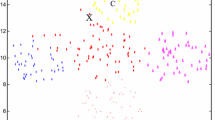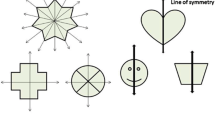Abstract
In this paper, at first a new line-symmetry-based distance is proposed. The properties of the proposed distance are then elaborately described. Kd-tree-based nearest neighbor search is used to reduce the complexity of computing the proposed line-symmetry-based distance. Thereafter an evolutionary clustering technique is developed that uses the new line-symmetry-based distance measure for assigning points to different clusters. Adaptive mutation and crossover probabilities are used to accelerate the proposed clustering technique. The proposed GA with line-symmetry-distance-based (GALSD) clustering technique is able to detect any type of clusters, irrespective of their geometrical shape and overlapping nature, as long as they possess the characteristics of line symmetry. GALSD is compared with the existing well-known K-means clustering algorithm and a newly developed genetic point-symmetry-distance-based clustering technique (GAPS) for three artificial and two real-life data sets. The efficacy of the proposed line-symmetry-based distance is then shown in recognizing human face from a given image.
Similar content being viewed by others
Explore related subjects
Discover the latest articles, news and stories from top researchers in related subjects.References
Jain A K, Murthy M N, Flynn P J. Data clustering: A review. ACM Computing Surveys, Nov. 1999, 31(3): 264–323.
Berg M D, Kreveld M V, Overmars M, Schwarzkopf O. Cluster Analysis for Application. Academic Press, 1973.
Duda R O, Hart P E. Pattern Classification and Scene Analysis. New York: Wiley, 1973.
Tou J T, Gonzalez R C. Pattern Recognition Principles. Reading: Addison-Wesley, 1974.
Everitt B S, Landau S, Leese M. Cluster Analysis. London: Arnold, 2001.
Jain A K, Dubes R C. Algorithms for Clustering Data. Prentice-Hall, Englewood Cliffs, NJ, 1988.
Kov̈esi B, Boucher J M, Saoodi S. Stochastic k-means algorithm for vector quantization. Pattern Recognition Letters, 2001, 22(6/7): 603–610.
Kanungo T, Mount D, Netanyahu N S, Piatko C, Silverman R, Wu A. An efficient k-means clustering algorithm: Analysis and implementation. IEEE Transaction on Pattern Analysis and Machine Intelligence, 2002, 24(7): 881–892.
Likas A, Vlassis N, Verbeek J J. The global k-means clustering algorithm. Pattern Recognition, 2003, 36(2): 451–461.
Charalampidis D. A modified k-means algorithm for circular invariant clustering. IEEE Transactions on Pattern Analysis and Machine Intelligence, December 2005, 27(12): 1856–1865.
Dave R N, Bhaswan K. Adaptive fuzzy c-shells clustering and detection of ellipses. IEEE Transaction on Neural Networks, September 1992, 3(5): 643–662.
Krishnapuram R, Nasraoui O, Frigui H. The fuzzy c-spherical shells algorithm: A new approach. IEEE Transaction on Neural Networks, September 1992, 3(5): 663–671.
Gath I, Gev A B. Unsupervised optimal fuzzy clustering. IEEE Transaction on Pattern Analysis and Machine Intelligence, 1989, 11: 773–780.
Gustafson D E, Kessel W C. Fuzzy clustering with a fuzzy covariance matrix. In Proc. IEEE Conf. Decision Contr., Ft. Lauderdale, USA, December 12–14, 1979, pp.761–766.
Dave R N. Use of the adaptive fuzzy clustering algorithm to detect lines in digital images. Intell. Robots Compt. Vision VIII, 1989, 1192(2): 600–611.
Man Y, Gath I. Detection and separation of ring-shaped clusters using fuzzy clustering. IEEE Transaction on Pattern Analysis and Machine Intelligence, 1994, 16(8): 855–861.
Höppner F. Fuzzy shell clustering algorithms in image processing: Fuzzy c-rectangular and 2-rectangular shells. IEEE Transaction Fuzzy Systems, Nov. 1997, 5(4): 599–613.
Bandyopadhyay S. An automatic shape independent clustering technique. Pattern Recognition, 2004, 37(1): 33–45.
Bandyopadhyay S, Saha S. GAPS: A clustering method using a new point symmetry-based distance measure. Pattern Recog., 2007, 40(12): 3430–3451.
Attneave F. Symmetry information and memory for pattern. Am. J. Psychology, 1995, 68(2): 209–222.
Su M C, Chou C H. A competitive learning algorithm using symmetry. IEICE Trans. Fundamentals of Electronics, Communications and Computer Sciences, 1999, E82-A(4): 680–687.
Su M C, Chou C H. A modified version of the k-means algorithm with a distance based on cluster symmetry. IEEE Transactions Pattern Analysis and Machine Intelligence, 2001, 23(6): 674–680.
Chou C H, Su M C, Lai E. Symmetry as a new measure for cluster validity. In Proc. the 2nd WSEAS Int. Conf. Scientific Computation and Soft Computing, Crete, Greece, 2002, pp.209–213.
Chung K L, Lin J S. Faster and more robust point symmetry-based k-means algorithm. Pattern Recogn., 2007, 40(2): 410–422.
M de Berg, M van Kreveld, M Overmars, O Schwarzkopf. Computational Geometry: Algorithms and Applications. 2nd Edition, Springer-Verlag, 2000, http://www.cs.uu.nl/geobook/.
Saha S, Bandyopadhyay S. A genetic clustering technique using a new line symmetry based distance measure. In Proc. the Fifth International Conference on Advanced Computing and Communications (ADCOM'07), IEEE Computer Society, Guwahati, India, 2007, pp.365–370.
Maulik U, Bandyopadhyay S. Genetic algorithm based clustering technique. Pattern Recog., 2000, 33(9): 1455–1465.
Holland J H. Adaptation in Natural and Artificial Systems. AnnArbor: The University of Michigan Press, 1975.
Bhuyan J N, Raghavan V V, Venkatesh K E. Genetic algorithm for clustering with an ordered representation. In Proc. Fourth International Conference on Genetic Algorithm, Morgan Kaufmann, San Diego, CA, USA, July 1991, pp.408–415.
Babu G P, Murty M N. A near-optimal initial seed value selection for k-means algorithm using genetic algorithm. Pattern Recognition Letters, 1993, 14(10): 763–769.
Krishna K, Murty M N. Genetic k-means algorithm. IEEE Transactions on Systems, Man, and Cybernetics — Part B, June 1999, 29(3): 433–439.
Bandyopadhyay S, Maulik U. Genetic clustering for automatic evolution of clusters and application to image classification. Pattern Recognition, 2002, 35(6): 1197–1208.
Gonzalez R C, Woods R E. Digital Image Processing. Massachusetts: Addison-Wesley, 1992.
Mount D M, Arya S. ANN: A library for approximate nearest neighbor searching. 2005, http://www.cs.umd.edu/~mount/ANN.
Srinivas M, Patnaik L. Adaptive probabilities of crossover and mutation in genetic algorithms. IEEE Transactions on Systems, Man and Cybernetics, April 1994, 24(4): 656–667.
Bentley J L, Weide B W, Yao A C. Optimal expected-time algorithms for closest point problems. ACM Transactions on Mathematical Software, 1980, 6(4): 563–580.
Friedman J H, Bently J L, Finkel R A. An algorithm for finding best matches in logarithmic expected time. ACM Transactions on Mathematical Software, 1977, 3(3): 209–226.
Harmon L D, Hunt W F. Automatic recognition of human face profiles. Computer Graphics and Image Processing, April 1977, 6(2): 135–156.
Zhao W, Chellappa R, Phillips P J, Rosenfeld A. Face recognition: A literature survey. ACM Computing Surveys, 2003, 35(4): 399–458.
Author information
Authors and Affiliations
Corresponding author
Rights and permissions
About this article
Cite this article
Saha, S., Bandyopadhyay, S. A New Line Symmetry Distance and Its Application to Data Clustering. J. Comput. Sci. Technol. 24, 544–556 (2009). https://doi.org/10.1007/s11390-009-9244-1
Received:
Revised:
Published:
Issue Date:
DOI: https://doi.org/10.1007/s11390-009-9244-1




